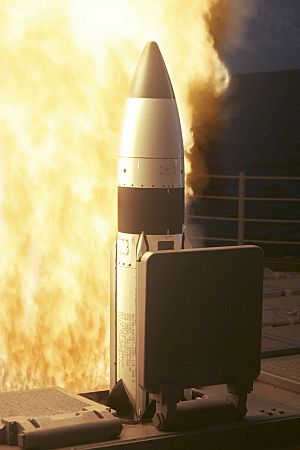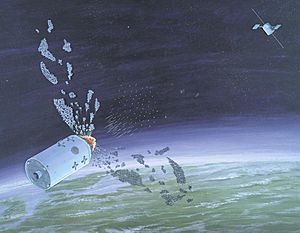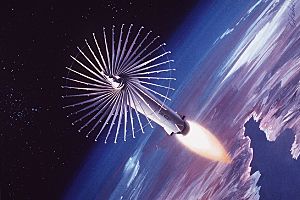Anti-satellite weapon facts for kids
Anti-satellite weapons (often called ASATs) are special weapons designed to damage or destroy satellites in space. Countries might want to do this for military reasons, like stopping an enemy from using their satellites to spy or communicate.
Even though no ASAT system has been used in a real war, a few countries (like China, India, Russia, and the United States) have successfully tested them. They did this by shooting down their own old satellites to show they have the technology. ASATs have also been used to safely remove satellites that are no longer working.
These weapons can be used in different ways. They might protect a country from an enemy's space weapons. They could also help a country gain an advantage in a conflict. Sometimes, they are used to stop an enemy's missile defense systems.
One big problem with using ASATs is that they create a lot of space debris. This is like space junk, and it can crash into other satellites, making even more debris. If too much debris builds up, it could cause a chain reaction called the Kessler syndrome. This would make space travel and using satellites very difficult or even impossible for a long time.
Contents
History of Anti-Satellite Weapons
The idea of anti-satellite weapons has been around for a while. In the 1950s, both the United States and the Soviet Union started developing ways to attack satellites. They first tried using missiles launched from the ground. Over time, many other interesting ideas for ASATs came up.
United States ASAT Programs
In the late 1950s, the US Air Force began working on advanced missile projects. One project was called Bold Orion. It was a missile launched from a B-47 Stratojet plane. They later changed it to be an anti-satellite weapon. In one test, the missile flew very close to a satellite called Explorer 6, about 4 miles away. This would have been close enough for a nuclear weapon, but not for a regular explosive.
Another similar project was High Virgo. It was also an air-launched missile. In 1959, it tried to hit Explorer 5. However, they lost contact with the missile, so they couldn't tell if the test worked. These early projects eventually stopped.
Later, in the 1960s, the US thought about using high-altitude nuclear explosions to destroy satellites. They noticed that nuclear blasts could damage electronics far away. For example, in 1962, a nuclear test called Starfish Prime damaged three satellites and caused power outages. The US also used a modified Nike Zeus missile as an ASAT from 1962 to 1975.
Scientists also researched directed-energy weapons, like powerful lasers. They even thought about a laser powered by a nuclear explosion! But this idea was stopped in 1977.

ASAT development wasn't a top priority for the US until 1982. That's when they learned more about the Soviet Union's successful ASAT program. This led to a new US project called the Vought ASM-135 ASAT. This missile was carried by a special F-15 Eagle jet.
On September 13, 1985, the F-15 launched the missile from 38,100 feet in the air. It successfully hit and destroyed a US gamma ray satellite called Solwind P78-1. The last piece of debris from this test fell back to Earth in 2004. Even though it worked, the program was canceled in 1988.
More recently, on February 21, 2008, the US Navy destroyed a broken spy satellite called USA-193. They used a missile launched from a ship, hitting the satellite about 153 miles above the Pacific Ocean. This test created 174 pieces of space junk. Most of this debris fell back to Earth within a few months.
Since 2022, the United States has stopped testing direct-ascent anti-satellite missiles.
Soviet Union ASAT Programs

The Soviet Union also worried about space weapons and started developing their own defenses. They tested an orbital anti-satellite (ASAT) weapon in 1968. This project was called Istrebitel Sputnikov (IS), which means "destroyer of satellites."
The IS system was "co-orbital." This means it would launch into orbit and then slowly get close to its target satellite. Once it was near, it would explode, sending shrapnel (small pieces of metal) to destroy the target. The missile would take about 90 to 200 minutes (one or two orbits) to reach its target. It was guided by radar on board.
The first successful intercept by the Soviet Union happened in February 1970. The system was officially ready for use in February 1973.
Testing of the IS system started again in 1976. This was partly because the Soviets were worried about the US Space Shuttle. Some believed the Shuttle could be used as a weapon. Even though the Soviet military knew this wasn't true, their leader, Leonid Brezhnev, ordered more ASAT tests. The IS system was improved to attack satellites at higher altitudes and was ready for use in this new form by July 1979. However, in 1983, all IS testing was stopped.
In the early 1980s, the Soviet Union also worked on an air-launched ASAT system, similar to the US one. They used modified MiG-31D 'Foxhound' jets to launch these missiles. They also experimented with putting cannons on their Almaz space stations. Another Soviet project was a space station called Polyus, which had a powerful laser, but it failed to launch in 1987.
In 1987, Soviet leader Mikhail Gorbachev was shown an anti-satellite system called "Naryad," launched by UR-100N rockets.
ASATs and Strategic Defense
The idea of a Strategic Defense Initiative (SDI), proposed in 1983, focused on defending against nuclear missiles. However, some of the technologies developed for SDI could also be used for anti-satellite purposes.
SDI gave a big push to both US and Soviet ASAT programs. Many ASAT projects were changed to work as anti-missile systems, and vice versa. The US planned to use small kinetic interceptors (which destroy targets by hitting them) in space. They imagined a group of 4,600 small satellites, each weighing about 100 pounds, orbiting Earth.
Both countries found that building space-based energy weapons, like lasers, was very difficult with the technology available at the time. Despite this, the possibility of a major breakthrough made the Soviet Union spend a lot of money on research.
Both countries started spending less on these programs from 1989. Russia officially stopped all SDI research in 1992. However, there have been reports that Russia has restarted some ASAT and space weapon research. The US has also been working on new programs that could be used for space-based ASATs.
Law and ASATs
On November 1, 2022, a United Nations group passed a resolution. This resolution asked countries to stop destructive anti-satellite missile tests. While this rule is not legally binding, it shows that more countries want to ban these weapons. Some countries have pointed out that the United States has already tested its ASAT capabilities. Because of this, they feel that this US-backed resolution might limit other countries' progress in developing their own ASAT systems.
See Also
 In Spanish: Arma antisatélite para niños
In Spanish: Arma antisatélite para niños
- Anti-ballistic missile
- Deep Black (1986 book)
- High-altitude nuclear explosion
- Kessler syndrome
- Kill vehicle
- Militarisation of space
- Multiple Kill Vehicle
- Outer Space Treaty
- Space debris
- Space gun
- Space warfare





